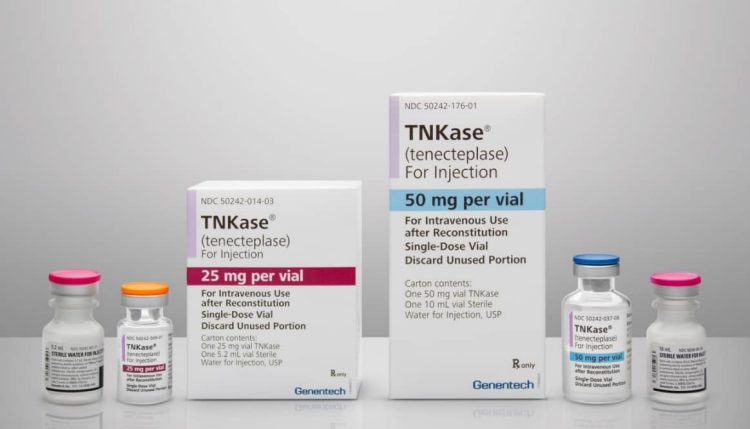FDA APPROVED FOR ACUTE ISCHEMIC STROKE1

FDA APPROVED FOR ACUTE ISCHEMIC STROKE1

IV=intravenous.
Integrating TNKase into practice
Could the single 5-second IV bolus administration of TNKase benefit your patients with acute ischemic stroke?

-
-
TNKase Prescribing Information. South San Francisco, CA. Genentech, Inc.
TNKase Prescribing Information. South San Francisco, CA. Genentech, Inc.
-
Tsao CW, Aday AW, Almarzooq ZI, et al. Heart disease and stroke statistics—2023 update: a report from the American Heart Association. Circulation. 2023;147(8):e93-e621. doi:10.1161/CIR.0000000000001123
Tsao CW, Aday AW, Almarzooq ZI, et al. Heart disease and stroke statistics—2023 update: a report from the American Heart Association. Circulation. 2023;147(8):e93-e621. doi:10.1161/CIR.0000000000001123
-
Centers for Disease Control and Prevention. Stroke facts. Updated October 24, 2024. Accessed March 20, 2025. https://www.cdc.gov/stroke/data-research/facts-stats/index.html
Centers for Disease Control and Prevention. Stroke facts. Updated October 24, 2024. Accessed March 20, 2025. https://www.cdc.gov/stroke/data-research/facts-stats/index.html
-
Winstein CJ, Stein J, Arena R, et al. Guidelines for adult stroke rehabilitation and recovery: a guideline for healthcare professionals from the American Heart Association/American Stroke Association. Stroke. 2016;47(6):e98-e169. doi:10.1161/STR.0000000000000098
Winstein CJ, Stein J, Arena R, et al. Guidelines for adult stroke rehabilitation and recovery: a guideline for healthcare professionals from the American Heart Association/American Stroke Association. Stroke. 2016;47(6):e98-e169. doi:10.1161/STR.0000000000000098
-
Saver JL. Time is brain—quantified. Stroke. 2006;37(1):263-266. doi:10.1161/01.STR.0000196957.55928.ab
Saver JL. Time is brain—quantified. Stroke. 2006;37(1):263-266. doi:10.1161/01.STR.0000196957.55928.ab
-
El-Koussy M, Schroth G, Brekenfeld C, Arnold M. Imaging of acute ischemic stroke. Eur Neurol. 2014;72(5-6):309-316. doi:10.1159/000362719
El-Koussy M, Schroth G, Brekenfeld C, Arnold M. Imaging of acute ischemic stroke. Eur Neurol. 2014;72(5-6):309-316. doi:10.1159/000362719
-
Heiss WD. The ischemic penumbra: correlates in imaging and implications for treatment of ischemic stroke. The Johann Jacob Wepfer Award 2011. Cerebrovasc Dis. 2011;32(4):307-320. doi:10.1159/000330462
Heiss WD. The ischemic penumbra: correlates in imaging and implications for treatment of ischemic stroke. The Johann Jacob Wepfer Award 2011. Cerebrovasc Dis. 2011;32(4):307-320. doi:10.1159/000330462
-
Powers WJ, Rabinstein AA, Ackerson T, et al. Guidelines for the early management of patients with acute ischemic stroke: 2019 update to the 2018 guidelines for the early management of acute ischemic stroke: a guideline for healthcare professionals from the American Heart Association/American Stroke Association. Stroke. 2019;50(12):e344-e418. doi:10.1161/STR.0000000000000211
Powers WJ, Rabinstein AA, Ackerson T, et al. Guidelines for the early management of patients with acute ischemic stroke: 2019 update to the 2018 guidelines for the early management of acute ischemic stroke: a guideline for healthcare professionals from the American Heart Association/American Stroke Association. Stroke. 2019;50(12):e344-e418. doi:10.1161/STR.0000000000000211
-
Arch AE, Weisman DC, Coca S, Nystrom KV, Wira CR III, Schindler JL. Missed ischemic stroke diagnosis in the emergency department by emergency medicine and neurology services [published correction appears in Stroke. 2016 Mar;47(3):e59. doi:10.1161/STR.0000000000000099]. Stroke. 2016;47(3):668-673. doi:10.1161/STROKEAHA.115.010613
Arch AE, Weisman DC, Coca S, Nystrom KV, Wira CR III, Schindler JL. Missed ischemic stroke diagnosis in the emergency department by emergency medicine and neurology services [published correction appears in Stroke. 2016 Mar;47(3):e59. doi:10.1161/STR.0000000000000099]. Stroke. 2016;47(3):668-673. doi:10.1161/STROKEAHA.115.010613
-
Demaerschalk BM, Kleindorfer DO, Adeoye OM, et al. Scientific rationale for the inclusion and exclusion criteria for intravenous alteplase in acute ischemic stroke: a statement for healthcare professionals from the American Heart Association/American Stroke Association. Stroke. 2016;47(2):581-641. doi:10.1161/STR.0000000000000086
Demaerschalk BM, Kleindorfer DO, Adeoye OM, et al. Scientific rationale for the inclusion and exclusion criteria for intravenous alteplase in acute ischemic stroke: a statement for healthcare professionals from the American Heart Association/American Stroke Association. Stroke. 2016;47(2):581-641. doi:10.1161/STR.0000000000000086
-
Menon BK, Buck BH, Singh N, et al. Intravenous tenecteplase compared with alteplase for acute ischaemic stroke in Canada (AcT): a pragmatic, multicentre, open-label, registry-linked, randomised, controlled, non-inferiority trial. Lancet. 2022;400(10347):161-169. doi:10.1016/S0140-6736(22)01054-6
Menon BK, Buck BH, Singh N, et al. Intravenous tenecteplase compared with alteplase for acute ischaemic stroke in Canada (AcT): a pragmatic, multicentre, open-label, registry-linked, randomised, controlled, non-inferiority trial. Lancet. 2022;400(10347):161-169. doi:10.1016/S0140-6736(22)01054-6
-
Cannon CP, McCabe CH, Gibson CM, et al. TNK-tissue plasminogen activator in acute myocardial infarction. Results of the Thrombolysis in Myocardial Infarction (TIMI) 10A dose-ranging trial. Circulation. 1997;95(2):351-356. doi:10.1161/01.cir.95.2.351
Cannon CP, McCabe CH, Gibson CM, et al. TNK-tissue plasminogen activator in acute myocardial infarction. Results of the Thrombolysis in Myocardial Infarction (TIMI) 10A dose-ranging trial. Circulation. 1997;95(2):351-356. doi:10.1161/01.cir.95.2.351
-
Keyt BA, Paoni NF, Refino CJ, et al. A faster-acting and more potent form of tissue plasminogen activator. Proc Natl Acad Sci U S A. 1994;91(9):3670-3674. doi:10.1073/pnas.91.9.3670
Keyt BA, Paoni NF, Refino CJ, et al. A faster-acting and more potent form of tissue plasminogen activator. Proc Natl Acad Sci U S A. 1994;91(9):3670-3674. doi:10.1073/pnas.91.9.3670
-
Bennett WF, Paoni NF, Keyt BA, et al. High resolution analysis of functional determinants on human tissue-type plasminogen activator. J Biol Chem. 1991;266(8):5191-5201.
Bennett WF, Paoni NF, Keyt BA, et al. High resolution analysis of functional determinants on human tissue-type plasminogen activator. J Biol Chem. 1991;266(8):5191-5201.
-
Warach SJ, Dula AN, Milling TJ, et al. Prospective observational cohort study of tenecteplase versus alteplase in routine clinical practice. Stroke. 2022;53(12):3583-3593. doi:10.1161/STROKEAHA.122.038950
Warach SJ, Dula AN, Milling TJ, et al. Prospective observational cohort study of tenecteplase versus alteplase in routine clinical practice. Stroke. 2022;53(12):3583-3593. doi:10.1161/STROKEAHA.122.038950
-
Campbell BCV, Mitchell PJ, Churilov L, et al. Tenecteplase versus alteplase before thrombectomy for ischemic stroke. N Engl J Med. 2018;378(17):1573-1582. doi:10.1056/NEJMoa1716405.
Campbell BCV, Mitchell PJ, Churilov L, et al. Tenecteplase versus alteplase before thrombectomy for ischemic stroke. N Engl J Med. 2018;378(17):1573-1582. doi:10.1056/NEJMoa1716405.
-
Hendrix P, Gross BA, Allahdadian S, et al. Tenecteplase versus alteplase before stroke thrombectomy: outcomes after system-wide transitions in Pennsylvania. J Neurol. 2024;271(8):5637-5641. doi:10.1007/s00415-024-12530-x
Hendrix P, Gross BA, Allahdadian S, et al. Tenecteplase versus alteplase before stroke thrombectomy: outcomes after system-wide transitions in Pennsylvania. J Neurol. 2024;271(8):5637-5641. doi:10.1007/s00415-024-12530-x
-
Seners P, Wouters A, Ter Schiphorst A, et al. Arterial recanalization during interhospital transfer for thrombectomy. Stroke. 2024;55(6):1525-1534. doi:10.1161/STROKEAHA.124.046694
Seners P, Wouters A, Ter Schiphorst A, et al. Arterial recanalization during interhospital transfer for thrombectomy. Stroke. 2024;55(6):1525-1534. doi:10.1161/STROKEAHA.124.046694
-
-
